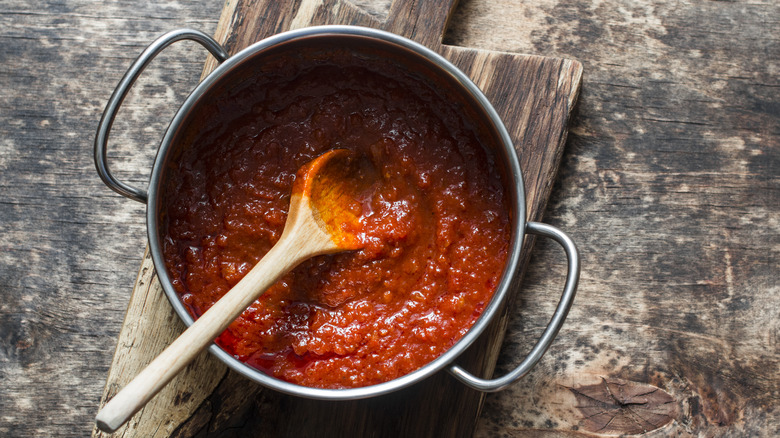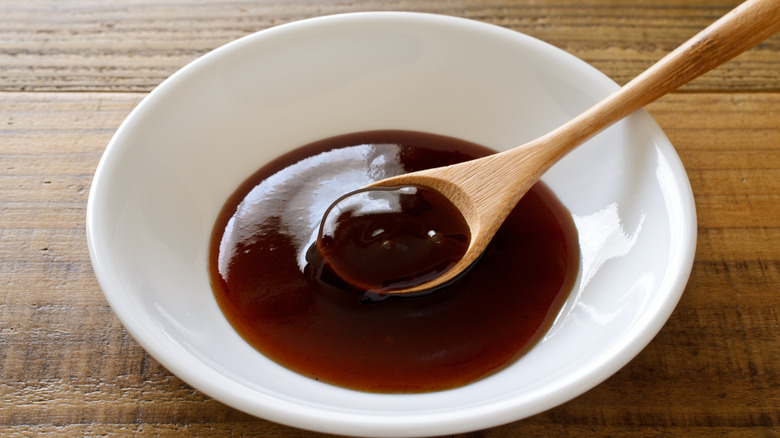Worcestershire Sauce Is A Game-Changer For Metallic-Tasting Tomato Sauce
Have you ever made a marinara sauce that should have come out perfect, but somehow tasted metallic? This may be because the canned tomatoes you used were treated with calcium chloride. This inorganic compound is used to firm up canned vegetables and fruits, and is a common addition in many cans of diced tomatoes. When the morsels are used in slow-cooking applications, the calcium chloride can't break down and cook fully, which can leave you with overly firm chunks that have the metallic taste and can seem undercooked.
Additives like this are why it's always best to check the ingredient list before buying canned tomatoes. Brands that don't contain calcium chloride will offer fruit that can cook down into a silkier sauce, such as plum tomatoes like San Marzanos that are one of the absolute best options for sauces.
Fortunately, it's not the end of the world if you've made a big pot of marinara and end up tasting this undesired quality — and there's no need to throw the contents out and start over. When you're in this situation, there's actually an unexpected and common condiment that can come to the rescue. The next time you're faced with a metallic-tasting sauce, reach for Worcestershire. Adding just a little bit can mellow out any metallic notes, while also amping up the natural flavors of your marinara.
Worcestershire's umami notes do the trick
Worcestershire's strong savory flavor can help amp up a tomato sauce's savory and sweet qualities and eliminate unwanted metallic flavors. Worcestershire is packed with glutamates, an amino acid that triggers the taste of umami. Foods that are rich in umami will taste intensely savory. Other high-glutamate foods include Parmesan cheese, mushrooms, and soy sauce. They too can be used to balance a sauce and provide a savory kick. (Just make sure to only add a little bit, otherwise, they will overpower the taste of the final dish.)
Worcestershire gets its glutamates from the large amounts of anchovies found in the condiment. Anchovies are already an intensely savory food, but the ones used in this case are fermented, giving them an even bigger dose of umami notes.
The only downside is that Worcestershire traditionally isn't vegetarian. Fortunately, there are plenty of versions of the sauce that don't contain fish and derive their glutamates from plant-based alternatives. Some of these aren't even advertised as vegetarian or vegan, so always take a look at the ingredient list. Even though these versions might not carry quite the same punch as the real deal, they're a great substitute for anyone following a vegetarian diet.
More tomato sauce hacks
There are plenty of other secret ingredients to use in your spaghetti sauce. Some of these might make your Italian nonna shudder, but others are ones she probably already uses. Best of all, many of the use ingredients you most likely already have in your pantry.
If your sauce is too acidic, try adding a little baking soda. The alkalinity of baking soda will counteract the acidity of the tomatoes. It will also make your sauce briefly flair up like an elementary school volcano project, so go slowly, giving it all a stir and letting it fizzle out. A pinch of sugar can also help counteract overly acidic or bitter flavors. This is especially important if you find yourself with underripe tomatoes that lack natural sweetness.
Other hacks are as simple as adding ingredients at the right time. If you're using tomato paste, don't just toss it in with whole tomatoes: Sauté it in oil first, which pulls out any metallic flavors in the paste and makes it taste more complex.



